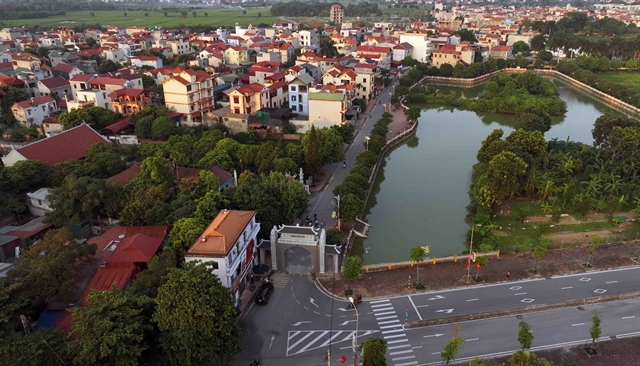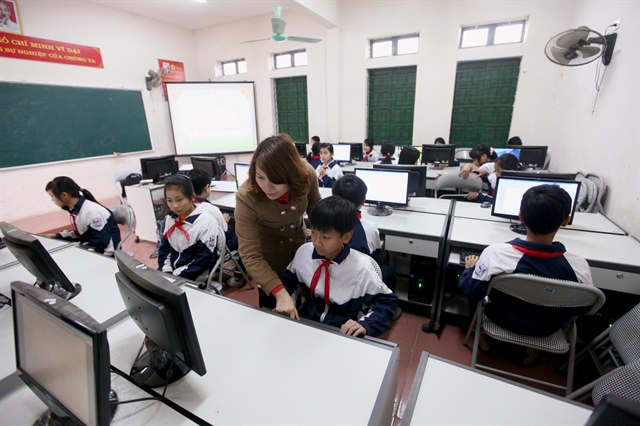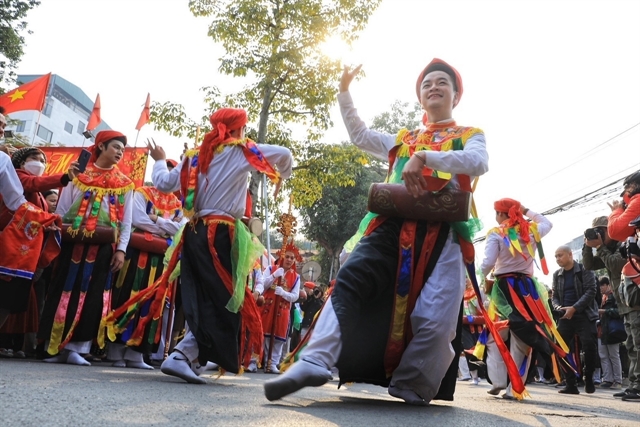 Society
Society

 |
| The face of new-style rural Hà Nội reflects both the modern, vibrant spirit of the city and the simple, peaceful charm of the countryside. |
HÀ NỘI — Over the past decade, Hà Nội’s rural areas have witnessed remarkable change – from poor, underdeveloped villages to vibrant communities with upgraded infrastructure, improved public services and rising living standards.
But beyond these tangible results, what truly defines Hà Nội’s success in building new-style rural areas is its ability to harmoniously blend modernisation with the preservation of deep-rooted cultural traditions.
Today, Hà Nội’s rural image is one of well-paved roads, neat rows of multi-storey houses beside vast green rice fields and modern classrooms nestled in quiet villages.
As the capital moves forward with rural development, it has consistently emphasised not only economic and infrastructure growth but also the preservation and promotion of traditional cultural values – a strategy that has shaped a unique blend of past and present across the countryside.
Sơn Tây Ward, located at the heart of the ancient Đoài region, is a vivid example. Known for its rich cultural heritage, the area is home to the ancient village of Đường Lâm, often referred to as the 'nucleus' of Sơn Tây’s history.
Here lie numerous national relics such as Và Temple (dedicated to Saint Tản Viên), Mía Pagoda, Phù Sa Communal House and the tombs of King Ngô Quyền and King Phùng Hưng.
"Our village has many old festivals and customs. For the death anniversaries of Kings Phùng Hưng, Ngô Quyền and scholar Giang Văn Minh, the local authorities organise the ceremonies, while villagers contribute offerings. Afterward, the whole village gathers to share the ceremonial meal. It’s a unique tradition that strengthens our community," said Mr. Phan Văn Lợi, a Đường Lâm resident.
In Đan Phượng Commune – one of Hà Nội’s standout examples of model rural development – the transformation is equally visible. Once muddy and dusty, the roads are now smoothly paved and lined with greenery. Basic services like electricity, clean water and waste management are well-regulated and modern.
"Life used to be tough here. Now our village is clean, well-organised, and comfortable. Our lives have truly improved, both materially and spiritually," shared local resident Nguyễn Văn Hùng.
 |
| Hà Nội’s rural areas are changing day by day, with continuously improving quality of life for local residents. |
According to Mr. Ngọ Văn Ngôn, Deputy Chief of the Standing Office for New Rural Development Coordination in Hà Nội, the city regards culture as a vital foundation and driving force for socio-economic progress. For that reason, Hà Nội has invested resources in fulfilling cultural criteria and safeguarding local traditions as essential assets.
"Village culture plays a key role in preserving Vietnamese identity – particularly the spirit of neighborliness and community solidarity," he noted. However, in the face of globalisation and the growing interaction between rural and urban lifestyles, preserving traditional values has become more challenging and urgent than ever.
To address this, Hà Nội’s Party Committee has implemented Programme No.04-CTr/TU, emphasising the need for well-planned development that balances rural and urban integration while protecting ecological landscapes and cultural heritage. Many localities have embraced this vision, becoming exemplary models in cultural preservation, economic growth and community cohesion.
As of July 1, 2025, Hà Nội officially adopted a two-tier local government model, establishing larger communes and wards with high population density and complex cultural landscapes. This change presents both opportunities and challenges in maintaining the unique identities of local communities.
Phúc Lộc Commune, newly formed from the merger of five former communes – Nam Hà, Vân Phúc, Xuân Đình, Sen Phương and Võng Xuyên – is home to over 60,000 residents and 46 villages. With dozens of traditional festivals, historical sites and craft villages, cultural preservation remains a top priority.
"Right after the new system took effect, we met with all village heads to align responsibilities and launch initiatives. We are continuing campaigns to maintain clean, green, safe neighborhoods, restore deteriorating relics,and foster a more civilized rural lifestyle," said Tô Văn Sáng, Secretary of the Phúc Lộc Commune Party Committee.
Hà Nội’s countryside is not just changing – it’s evolving with care. As the city presses forward with building advanced and model rural areas, culture remains a critical pillar. The capital is prioritising funding from the National Target Programme and other sources to restore traditional craft village spaces and conserve national and municipal relics in culturally rich communes.
 |
| Preserving and promoting the distinctive traditional cultural values of each region holds profound significance for Hà Nội – a capital city with a thousand-year legacy. |
Developing new-style rural areas, Hà Nội leaders emphasise, must go beyond economic metrics. It must protect and nurture the very soul of the village – customs, practices, values and identities that have shaped generations. In a city with a thousand-year legacy like Hà Nội, preserving the cultural uniqueness of each village is not only meaningful but essential. VNS
On June 22, 2025, the Prime Minister signed Decision No1226/QĐ-TTg officially recognising Hà Nội as having fulfilled its new-style rural development goals for the year 2024.
This milestone not only marks the completion of a key political task and contributes to the successful realisation of targets set by the 17th Congress of Hà Nôi's Party Committee, but also affirms the city’s position as a national leader in implementing the National Target Programme on New Rural Development," said Nguyễn Xuân Đại, Director of Hà Nội's Department of Agriculture and Environment, Chief of the Office for New Rural Development Coordination.
---------------
The article is published under the coordination of the Coordination Office of the New-Style Rural Development Programme in Hà Nội.




